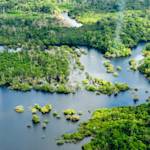Reforestation, Kasigau Corridor
2011 CE • Kenya
"Named after Mount Kasigau, which emerges from the East African plains between Kenya's Tsavo East and Tsavo West National Parks and rises to 1,641 meters, the Kasigau region is mostly what is called bushland. In ecological terms, 86 percent of the area is Acacia-Commiphora dryland forest. This refers to its dominance by relatively small trees and shrubs, without a closed canopy....Kasigau is also the location of one of the longest-running private efforts at large-scale conservation in Africa. Originally established in the late 1990s to provide a corridor for elephant migrations between the two Tsavo National Parks, it has been expanded in the past decade into a REDD+ program as well, designed to protect the carbon stock of about 200,000 hectares of woodland and dry forest. In the first phase of the conservation project, emissions were reduced by providing alternatives to slash-and-burn farming....In the second phase, the main focus has been on the land that was previously leased out to cattle ranchers, who were instead paid to lease the carbon rights to their land to Wildlife Works—the organization managing the project....By late 2012, revenues from the sale of voluntary carbon credits had already reached $1.2 million."
"Deforestation Success Stories, Tropical Nations Where Forest Protection and Reforestation Policies Have Worked," Union of Concerned Scientists, June 2014.
www.wildlifeworks.com


Learn about Maya Lin’s fifth and final memorial: a multi-platform science based artwork that presents an ecological history of our world - past, present, and future.

Discover ecological histories and stories of former abundance, loss, and recovery on the map of memory.

Learn how we can reduce our emissions and protect and restore species and habitats – around the world.

See how art can help us rethink the problems we face, and give us hope that each one of us can make a difference.

Help make a global memorial something personal and close to home. Share your stories of the natural world.


